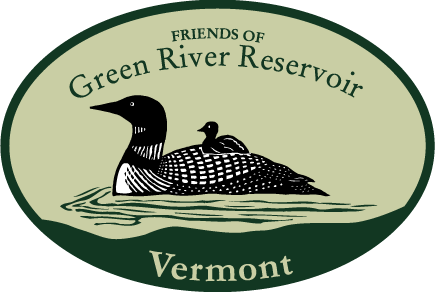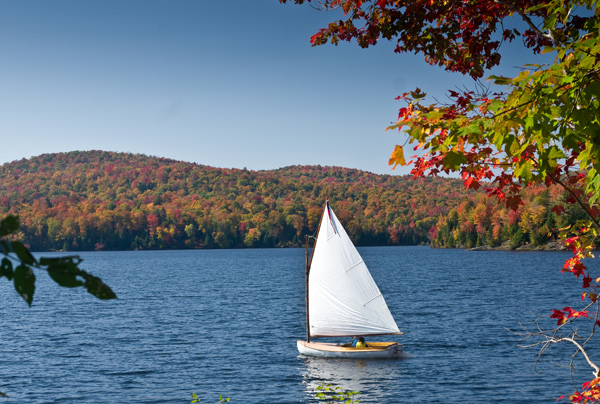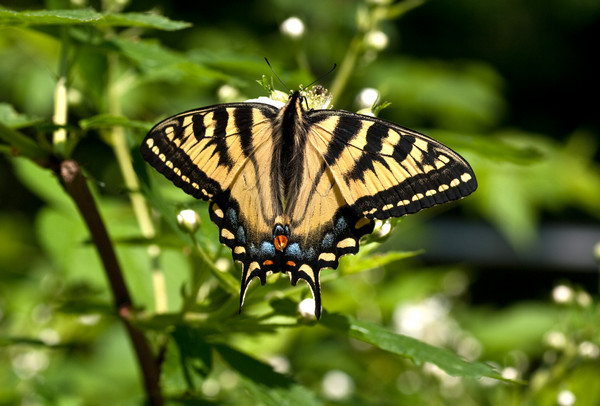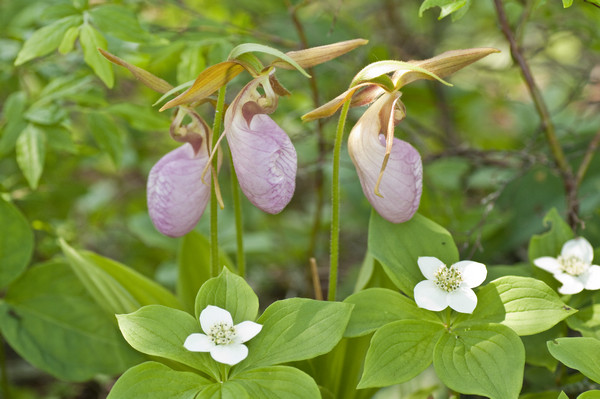Enjoying Green River Reservoir State Park
You can participate in a number of recreational activities in a “wilderness” setting, including canoeing, kayaking, fishing, remote site camping, hiking, horseback riding, mountain biking, watching wildlife, hunting or trapping in season, cross-country skiing and snowmobiling. The Vermont Department of Forests, Parks & Recreation (FPR) manages the area to offer outstanding high-quality recreational opportunities to visitors, including those with disabilities.
Natural History
The Green River Reservoir is a 5,113 acre park including a 653 acre Reservoir with 19 miles of shoreline, which is the longest stretch of undeveloped shoreline in Vermont. The landscape surrounding the Reservoir is a complex of forests, wetlands, ponds and other natural communities.
The extensive wetlands and 10 larger islands associated with the Reservoir provide important wildlife habitat, including a loon nesting site. Please stay at least 300 feet away from any loon nesting site as loons are very sensitive to human intrusion and disturbance. The park land encompasses much of Lamoille County’s largest deer wintering area and includes beaver ponds, wetlands, large stands of softwood and upland forest areas of mixed hardwoods. Many of the small ponds dotting the park property, including Schofield and Rush Ponds are excellent examples of undisturbed aquatic communities.
The main forest types found at Green River Reservoir are northern hardwoods (mostly beech, red maple, sugar maple, and yellow birch), mixed woods (hardwoods with hemlock, red spruce, white pine, balsam fir), and softwood stands (red spruce, balsam fir, white pine and hemlock). The forests and wetlands are home to birds such as thrushes, woodpeckers, flycatchers, wrens, vireos, warblers, blackbirds, grosbeaks, and sparrows. Waterfowl include common mergansers and common loons. Great blue herons, ospreys or “fish hawks”, and an occasional bald eagle can be seen in the area.
Area geology is predominately quartz-sericite-chlorite schist and phyllite. A band of greenstone and amphibolite runs along the western side of the park. This is Stowe formation rock overlain with glacial till and extensive gravel deposits (kame).
Green River Reservoir is home to mostly warm water fish species, such as small mouth bass and yellow perch. Brook trout inhabit the waters and inflowing streams.
Resources for Exploring the park
Tips For visiting the State Park
- Parking is limited and is available on a first come, first serve basis. Once the parking areas are full, visitors will not be allowed to enter the park.
- No parking is allowed on the shoulder of the town road or park access road.
- All users must register with a ranger. All campers must pay appropriate fees.
- All groups (8-12 people) must have a group permit and pay appropriate fees.
- Inspect and clean all boats, kayaks, and fishing gear for invasive species such as: Eurasian milfoil, water chestnuts and zebra mussels.
- Launch boats only at the access point at the southern end of the Reservoir near the dam.
- Motorized watercraft (motorboats, PWCs, floatplanes) are prohibited on the Reservoir. Electric motors are allowed, but watercraft may not exceed 5 mph (no wakes).
- To protect wildlife and respect other visitors, keep your dog close to you and under control at all times. Please do not leave your dog in the car! Dogs must be leashed in the access area.
- Where a composting or pit toilet is not provided, dig a hole 8 inches deep, 150 feet or more from water, trails, or campsites. Mix waste with soil and leaf litter.
- Please observe quiet hours between 10pm and 7 am. Voices and other sounds carry easily over the open water.
- Camp only at campsites designated with numbered sign posts and practice "Leave No Trace" camping.
- Only the allowed number of people may camp at each designated site. There is one designated group campsite (#21).
- Please pull kayaks and canoes away from the shoreline when not using them to protect shoreline vegitation and reduce shoreline erosion. Turning boats over also tidies up a campsite by reducing visual impact from the water. The put-in for canoes, kayaks and fishing boats is at the boat launch at the southern end of the Reservoir.
- Fires are allowed only at designated campsites or day use sites in the fire ring provided. Leave no fire unattended and make sure the fire is out before you leave. The best way to protect recreational areas is by using a portable stove instead of a campfire for cooking.
- Use only dead and down wood to build campfires. Please don’t cut, peel, dig, remove, write upon, destroy, damage, or remove any buildings, signs, live plants, trees, rocks, or other natural or manmade structures or features. In order to prevent the spread of invasive forest pests bringing your own firewood is discouraged. Only firewood harvested from within a 50 mile radius of the park will be allowed.
- Do not soap or rinse yourself, clothing, or dishes within 150 feet or more from any stream, pond, or water source.





